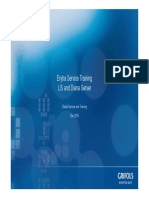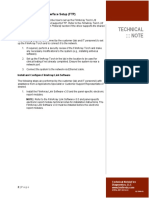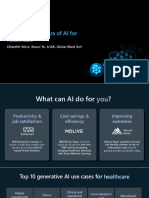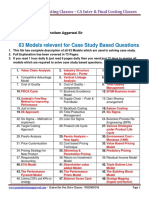Section-7 Middleware PDF
Section-7 Middleware PDF
Uploaded by
IberisCopyright:
Available Formats
Section-7 Middleware PDF
Section-7 Middleware PDF
Uploaded by
IberisOriginal Description:
Original Title
Copyright
Available Formats
Share this document
Did you find this document useful?
Is this content inappropriate?
Copyright:
Available Formats
Section-7 Middleware PDF
Section-7 Middleware PDF
Uploaded by
IberisCopyright:
Available Formats
SECTION 7
REPORTS AND
ANALYTICS
LEARNING OBJECTIVES
When you complete this section, you will be able to:
• Distinguish between different types of middleware reports
• Understand the value of available management reports
• Recognize some of the key metrics that laboratories use to track performance
31 LEARNING GUIDE: MIDDLEWARE USE & OPERATION
SECTION 7 – REPORTS AND ANALYTICS
Laboratory managers demand timely metrics to track laboratory performance and quality.18
A middleware solution addresses this critical need by consolidating test data and providing real-
time statistical reports that help laboratories track, understand and manage their performance.
Additionally, middleware can present insights regarding the business performance of the
laboratory in easy to read and understand reports.
During the processing of one patient sample, hundreds of data points may be generated. This
information is used to not only direct patient care decisions, but also to monitor the laboratory’s
performance against internal and external benchmarks. Hematology laboratories, for example,
generate a tremendous volume of test results data from automated analyzers, including CBCs.
Unique aspects of Hematology are the CBC scatterplots as well as morphological images from
slide review which are linked to each patient sample. There are multiple reporting and analytics
functionality that can help the laboratories track and visualize these data.
The different reports and statistics offered by middleware can be extensive. The following is a list
of some of the popular management reports provided by middleware.
• Turnaround time (TAT) analysis – tracks the time it takes for the lab to process a patient
test request from sample receipt in the laboratory to results reported to the clinical staff. The
timeliness of laboratories to report final test results is expressed as the turnaround time, and
often used as a key effectiveness metric to measure laboratory performance.
Figure 7.1 Turnaround time (TAT) report from Abbott’s AlinIQ Analyzer Management System (AMS). For illustrative
purposes only.
LEARNING GUIDE: MIDDLEWARE USE & OPERATION 32
• Workload volume – counts workload trends by patients, samples and tests over a time period
(hourly, daily, weekly, monthly).
Figure 7.2 Workload report from Abbott’s AlinIQ Analyzer Management System (AMS). For illustrative purposes only.
33 LEARNING GUIDE: MIDDLEWARE USE & OPERATION
• Analyzer utilization – tracks volumes, shifts and trends in test runs and analyzer
performance.
Figure 7.3 Analyzer utilization report from Abbott’s AlinIQ Analyzer Management System (AMS). For illustrative
purposes only.
With these metrics readily available, laboratories can more easily derive actionable insights from
their test results and associated activities to achieve their efficiency and performance goals.18
The automated analytics and reports provided by middleware offer essential tools to monitor
and improve quality assurance processes. By tracking, monitoring, verifying and improving the
standard of performance of all the different processes in sample testing operations, errors can be
reduced, which can invariably lead to improved staff, test and analyzer utilization.
Now complete the section Quiz.
LEARNING GUIDE: MIDDLEWARE USE & OPERATION 34
You might also like
- 2 Oracle HCM Exam 1Z0 1046 22Document55 pages2 Oracle HCM Exam 1Z0 1046 22ahmad zakiNo ratings yet
- NextGen Connect Fundamentals Certification Exam InformationDocument7 pagesNextGen Connect Fundamentals Certification Exam InformationM FieldsNo ratings yet
- AlinIQ AMS Frequently Asked QuestionsDocument19 pagesAlinIQ AMS Frequently Asked QuestionssootjeNo ratings yet
- Abbott Introduces GLP Systems Automation ReinventedDocument2 pagesAbbott Introduces GLP Systems Automation ReinventedsootjeNo ratings yet
- BSBOPS505 - Assessment Task 3Document16 pagesBSBOPS505 - Assessment Task 3Nadia RiazNo ratings yet
- Erba EC 90 Brochure WEB 2023Document4 pagesErba EC 90 Brochure WEB 2023Upama SahaNo ratings yet
- Becton DickinsonDocument134 pagesBecton DickinsonMaxime KIENOUNo ratings yet
- CCG-PIMA-02-01-En Alere Connectivity Pack III Configuration Guide For Pima AnalyserDocument11 pagesCCG-PIMA-02-01-En Alere Connectivity Pack III Configuration Guide For Pima AnalyserMichaelNo ratings yet
- Connectionsaqt For Empower 3: Requirements Before Qualification BeginsDocument45 pagesConnectionsaqt For Empower 3: Requirements Before Qualification BeginsJorge MorenoNo ratings yet
- BIOMERIEUX - BacTAlert - 3D - Select LIS Interface Func Rqmts Rev A.00Document6 pagesBIOMERIEUX - BacTAlert - 3D - Select LIS Interface Func Rqmts Rev A.00Jose Perez PerezNo ratings yet
- Erytra FSE LIS - ConfigurationDocument29 pagesErytra FSE LIS - ConfigurationRonan ColobongNo ratings yet
- Labureader Plus 2: Semi-Automated Urine Chemistry AnalyzerDocument2 pagesLabureader Plus 2: Semi-Automated Urine Chemistry AnalyzerCARLOSNo ratings yet
- Schedule Manager For Process ExecutionDocument59 pagesSchedule Manager For Process ExecutionmohanNo ratings yet
- Test Management: Section 2Document3 pagesTest Management: Section 2IberisNo ratings yet
- Section-7 Middleware PDFDocument4 pagesSection-7 Middleware PDFIberisNo ratings yet
- I-STAT Hospital Navigator BrochureDocument19 pagesI-STAT Hospital Navigator BrochureClaudia SotoNo ratings yet
- CLX 120 HL7 Interface User's ManualDocument50 pagesCLX 120 HL7 Interface User's Manualmircea0% (1)
- Fus 2000. Lis Interface Astm & HL7Document37 pagesFus 2000. Lis Interface Astm & HL7Renan FilipeNo ratings yet
- BD Diagnostic Systems CatalogueDocument197 pagesBD Diagnostic Systems CatalogueadvokatdaliborNo ratings yet
- ORTHO VISION Sales-Aid-2014-10-01-v2Document5 pagesORTHO VISION Sales-Aid-2014-10-01-v2Aldino BagousNo ratings yet
- CobasDocument8 pagesCobasNanda Nabilah UbayNo ratings yet
- 5600 Host Interface ManualDocument47 pages5600 Host Interface ManualRavi ShravgirNo ratings yet
- P.abbott LabDocument206 pagesP.abbott LabSohail AusafNo ratings yet
- Siemens LIS Interface GuideDocument144 pagesSiemens LIS Interface GuideAliKhNo ratings yet
- Skyway LIMS OverviewDocument52 pagesSkyway LIMS OverviewSFC ABHA 1No ratings yet
- ADVIA Centaur XPT Immunoassay System Quick Reference Guide, English, REF 10816028, 2014-10 DXDCM 09008b838074f4e3-1424484889515Document30 pagesADVIA Centaur XPT Immunoassay System Quick Reference Guide, English, REF 10816028, 2014-10 DXDCM 09008b838074f4e3-1424484889515yousrazeidan1979100% (1)
- Smart Lab E BookDocument24 pagesSmart Lab E BookNaveed MubarikNo ratings yet
- Abbott CatalogueDocument8 pagesAbbott CataloguekadirucaNo ratings yet
- A Manual For A Laboratory Information Management System (Lims) For Light Stable IsotopesDocument131 pagesA Manual For A Laboratory Information Management System (Lims) For Light Stable IsotopesAlvaro Felipe Rebolledo ToroNo ratings yet
- 1 What Is HL7?: Health Level Seven (HL7) Is A Standard Series of Predefined Logical Formats For PackagingDocument3 pages1 What Is HL7?: Health Level Seven (HL7) Is A Standard Series of Predefined Logical Formats For PackagingpvenkatkrishnaNo ratings yet
- Landwind LWC Lis Transfer ProtocolDocument11 pagesLandwind LWC Lis Transfer ProtocolEugen SerovNo ratings yet
- Cobas E-Library: Operator's Manual Software Version 2.4.0Document62 pagesCobas E-Library: Operator's Manual Software Version 2.4.0Meloga PlusNo ratings yet
- Cobas Infinity Lab Flow Module ManualDocument264 pagesCobas Infinity Lab Flow Module ManualsootjeNo ratings yet
- Alinity Ci HL7Document200 pagesAlinity Ci HL7festez71No ratings yet
- Laboratory Execution System Les BrochureDocument4 pagesLaboratory Execution System Les BrochureChRiZtIaN16No ratings yet
- XS-1000 Automated Hematology Analyzer: Small Footprint. Big DifferenceDocument4 pagesXS-1000 Automated Hematology Analyzer: Small Footprint. Big Differencerizal_aspanNo ratings yet
- Spec Alinity SeriesDocument2 pagesSpec Alinity SeriesYetzh HayatiNo ratings yet
- Architect c8000 PM ChecklistDocument2 pagesArchitect c8000 PM ChecklistALONSO GARCIANo ratings yet
- HL7 GuidelinesDocument83 pagesHL7 GuidelinesVito WilfredoNo ratings yet
- Types of Software TestingDocument18 pagesTypes of Software Testinghira fatimaNo ratings yet
- Automated Hematology Analyzer XN-L Series ASTM Host Interface SpecificationsDocument78 pagesAutomated Hematology Analyzer XN-L Series ASTM Host Interface SpecificationsSowji P0% (1)
- Technical::: Note: Filmarray Torch Lis Interface Setup (FTP)Document4 pagesTechnical::: Note: Filmarray Torch Lis Interface Setup (FTP)Axel GrullonNo ratings yet
- SUIT Protocol Description v8.0-1Document59 pagesSUIT Protocol Description v8.0-1ahmed1319No ratings yet
- Market Research Survey ReportDocument16 pagesMarket Research Survey Reportiyad.alsabiNo ratings yet
- Proces wp001 - en P PDFDocument16 pagesProces wp001 - en P PDFReinaldo GomezNo ratings yet
- Cobas c111Document38 pagesCobas c111Kiwon ShimNo ratings yet
- 638 DXH 520 Hematology Analyzer Brochure BR 66953 en GLB A4Document12 pages638 DXH 520 Hematology Analyzer Brochure BR 66953 en GLB A4Madness InvokerNo ratings yet
- Clinical Chemistry, Immunoassay and Integrated Systems To Transform Your LaboratoryDocument12 pagesClinical Chemistry, Immunoassay and Integrated Systems To Transform Your Laboratoryconcursoprf685No ratings yet
- Ves Matic Cube ASTM Specifications 1 - 1Document10 pagesVes Matic Cube ASTM Specifications 1 - 1Jason HullNo ratings yet
- Allscripts Common Interface Engine Presentation For Allscripts West Regional User Group Winter MeetingDocument24 pagesAllscripts Common Interface Engine Presentation For Allscripts West Regional User Group Winter MeetingJC CampbellNo ratings yet
- BK-200 User ManualDocument179 pagesBK-200 User ManualNBL AmouchasNo ratings yet
- pHOx Advanced User ManualDocument106 pagespHOx Advanced User ManualErick Jr Cardozo Romero100% (1)
- Meril Autoquant 100 Astm-Protocol - Rev1.2Document20 pagesMeril Autoquant 100 Astm-Protocol - Rev1.2Nivesh SharmaNo ratings yet
- Immu Lite 1000Document6 pagesImmu Lite 1000ciolo1981No ratings yet
- Perkin Elmer 44-135800SPC June 11 GSP Instrument SpecificationsDocument4 pagesPerkin Elmer 44-135800SPC June 11 GSP Instrument SpecificationsKhorana100% (1)
- Internal Technical Note 8.60 20130102 FV - enDocument82 pagesInternal Technical Note 8.60 20130102 FV - enVu Anh100% (1)
- LIS Interface: /EDIC@Document18 pagesLIS Interface: /EDIC@MatrixNo ratings yet
- 121 ASTM Interface ManualDocument70 pages121 ASTM Interface ManualReach Business Software Pvt LtdNo ratings yet
- LABWORKS 6.9 Admin GuideDocument534 pagesLABWORKS 6.9 Admin GuideBilla SathishNo ratings yet
- DSG AU2700 AU5400 LISspecsDocument65 pagesDSG AU2700 AU5400 LISspecsquangbo1310No ratings yet
- Statistical Methods for Evaluating Safety in Medical Product DevelopmentFrom EverandStatistical Methods for Evaluating Safety in Medical Product DevelopmentA. Lawrence GouldNo ratings yet
- Megakaryopoiesis: and ThrombopoiesisDocument2 pagesMegakaryopoiesis: and ThrombopoiesisIberisNo ratings yet
- Red Blood: CellsDocument4 pagesRed Blood: CellsIberisNo ratings yet
- Overview Of: BloodDocument4 pagesOverview Of: BloodIberisNo ratings yet
- Sec6 2 PDFDocument2 pagesSec6 2 PDFIberisNo ratings yet
- Sec5 3Document6 pagesSec5 3IberisNo ratings yet
- Disorders of Red Blood: CellsDocument4 pagesDisorders of Red Blood: CellsIberisNo ratings yet
- Pre-Analytical Factors of Platelet: CountingDocument2 pagesPre-Analytical Factors of Platelet: CountingIberisNo ratings yet
- The Discovery of PlateletsDocument4 pagesThe Discovery of PlateletsIberisNo ratings yet
- Interferences in Platelet: CountingDocument5 pagesInterferences in Platelet: CountingIberisNo ratings yet
- Platelet Counting: MethodsDocument7 pagesPlatelet Counting: MethodsIberisNo ratings yet
- Secondary: HemostasisDocument5 pagesSecondary: HemostasisIberisNo ratings yet
- Fibrinolysis: Choose Transformation™Document3 pagesFibrinolysis: Choose Transformation™IberisNo ratings yet
- Expert Decision Rules: Section 4Document6 pagesExpert Decision Rules: Section 4IberisNo ratings yet
- CLG Chapter2 1Document5 pagesCLG Chapter2 1IberisNo ratings yet
- Sample Management: Section 3Document2 pagesSample Management: Section 3IberisNo ratings yet
- CLG Chapter5 PDFDocument5 pagesCLG Chapter5 PDFIberisNo ratings yet
- Reports and Analytics: Section 7Document4 pagesReports and Analytics: Section 7IberisNo ratings yet
- Analyzer and Laboratory Automation System Management: Section 6Document3 pagesAnalyzer and Laboratory Automation System Management: Section 6IberisNo ratings yet
- Quality Management: Section 5Document3 pagesQuality Management: Section 5IberisNo ratings yet
- Section-1 MiddlewareDocument4 pagesSection-1 MiddlewareIberisNo ratings yet
- Disorders of White Blood: CellsDocument2 pagesDisorders of White Blood: CellsIberisNo ratings yet
- Platelets and Hemorrhagic: DisordersDocument3 pagesPlatelets and Hemorrhagic: DisordersIberisNo ratings yet
- Laboratory Safety Guidelines: Learning Guide SeriesDocument6 pagesLaboratory Safety Guidelines: Learning Guide SeriesIberisNo ratings yet
- Sec7 3 PDFDocument3 pagesSec7 3 PDFIberisNo ratings yet
- Noman Mustafa ResumeDocument1 pageNoman Mustafa ResumeZoya TanveerNo ratings yet
- Setting Up and Maintaining Standard Costs-2Document49 pagesSetting Up and Maintaining Standard Costs-2Syed Vaisul KarneNo ratings yet
- FWD New AFE FormDocument2 pagesFWD New AFE FormORGONEXS BUSINESS COACHESNo ratings yet
- MSFT AzureAIHealthcare DhanshriXiaoqi Feb8Document16 pagesMSFT AzureAIHealthcare DhanshriXiaoqi Feb8vandnanNo ratings yet
- From Inception of Operations To December 31 2008 Blaise PascalDocument1 pageFrom Inception of Operations To December 31 2008 Blaise PascalM Bilal SaleemNo ratings yet
- SAP Cloud Identity Services - Identity Authentication, Solution OverviewDocument36 pagesSAP Cloud Identity Services - Identity Authentication, Solution OverviewishtiaqalamNo ratings yet
- Post-Quiz - Attempt ReviewDocument3 pagesPost-Quiz - Attempt Reviewvinay MurakambattuNo ratings yet
- ONDC Integration Guide-3Document38 pagesONDC Integration Guide-3abhishek mandingiNo ratings yet
- Unit 1Document13 pagesUnit 1abhimanyu chauhanNo ratings yet
- Business Plan Karting PDFDocument7 pagesBusiness Plan Karting PDFrhhvnrbie100% (1)
- Cookbook SAP Recycling Administration - REA Datamodel ExtensibilityDocument19 pagesCookbook SAP Recycling Administration - REA Datamodel Extensibilityercole novelloNo ratings yet
- IC Technical Engineering Due Diligence Checklist 10584Document5 pagesIC Technical Engineering Due Diligence Checklist 10584Sarim Saleheen LariNo ratings yet
- Salesforce Admin Student Guide - 1 IntroductionDocument232 pagesSalesforce Admin Student Guide - 1 IntroductionsureshNo ratings yet
- The Curious Case of The Semantic Data CatalogDocument15 pagesThe Curious Case of The Semantic Data CatalogBruno OliveiraNo ratings yet
- Internship Letter of SAPDocument7 pagesInternship Letter of SAPFurqanNo ratings yet
- Temu Shop For Clothing, Shoes, Jewelry, BeautyDocument1 pageTemu Shop For Clothing, Shoes, Jewelry, BeautyGregPlaysHD GamezNo ratings yet
- Pitch Deck-Community PlatformDocument19 pagesPitch Deck-Community PlatformshrutiwahiNo ratings yet
- Apple Inc Business Continuity PlanDocument7 pagesApple Inc Business Continuity Planafwdbnbfd100% (1)
- Ey How Banks Can Leverage Digital Innovation To Compete in The Fast Changing SMB Market v2Document17 pagesEy How Banks Can Leverage Digital Innovation To Compete in The Fast Changing SMB Market v2Prajapati BhavikMahendrabhaiNo ratings yet
- Group Ii - June 2022Document77 pagesGroup Ii - June 2022ANISH KAFLENo ratings yet
- How Hotel Smartphone Applications Affect Guest Satisfaction in Applications and Re-Use Intention? An Experiential Value ApproachDocument26 pagesHow Hotel Smartphone Applications Affect Guest Satisfaction in Applications and Re-Use Intention? An Experiential Value ApproachMuhammad Haroon Ul HasnainNo ratings yet
- Unit Revision-Integrated Systems For Business EnterprisesDocument8 pagesUnit Revision-Integrated Systems For Business EnterprisesAbby JiangNo ratings yet
- 3 Methods To Generate A PDF Output and Send Using Floe SAPDocument8 pages3 Methods To Generate A PDF Output and Send Using Floe SAPkoizak3No ratings yet
- SCM & PE 63 Models Case StudyDocument77 pagesSCM & PE 63 Models Case StudyVinayakNo ratings yet
- Rhea Jona A. Alopoop: Personal Profile Career ObjectiveDocument3 pagesRhea Jona A. Alopoop: Personal Profile Career ObjectiveRomena Jean AlopoopNo ratings yet
- Interactive Session: Organizations: Domino'S Sizzles With Pizza TrackerDocument2 pagesInteractive Session: Organizations: Domino'S Sizzles With Pizza TrackerAsifNo ratings yet
- Chapter 2 - Strategy and TechnologyFileDocument58 pagesChapter 2 - Strategy and TechnologyFileRamana KrishnaNo ratings yet

















































































































